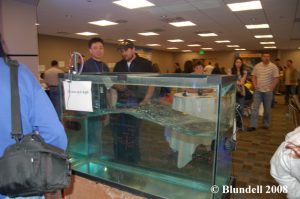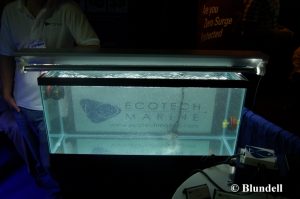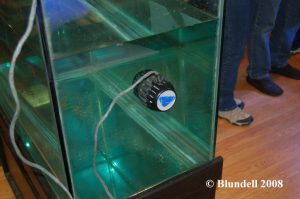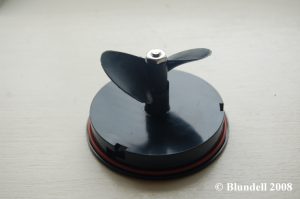Authors Note – Between the time of writing this article and the publication date, I discovered that a friend of mine was also working with this product. Jake Adams and I are now working together to co-author a piece showing some of advanced VorTech capabilities.
Introduction
Buy this pump! I decided to start this article off with that sentence just to make sure every reader saw it. I’ve tried out many products and I’ve seen all the developments and designs used for water motion. The capabilities of the vortech (mostly derived from the software based computer system) are really second to none.
Background
My interest in the vortech pump stemmed from my constant battle with finding my ideal water flow. I’ll admit that I frequently change my opinion on just what is the best flow, but I’ve always been leery of laminar flow found in gyre systems. My take is to mix it up and keep it going. In recent months my friend and fellow author Jake Adams has produced some compelling arguments for laminar flow, and I’ll address those ideas next month. However I still like some back and forth sloshing in my tank. When it comes to changing up the flow in your tank, nothing beats the vortech.
VorTech Basics
The EcoTech Marine vortech pump is a propeller style pump. Propeller pumps have made a huge splash in the hobby. Over the last couple years we’ve seen numerous modification kits and even propeller designed pumps take of the market. The vortech, however, features a couple unique features.
Magnetic Induction – one of the highly promoted aspects of the vortech is the induction driven pump. This means that the pump sits on the outside of the tank and magnetically drives the propeller on the inside of the tank. This helps to reduce the amount of heat entering the system as the pump is not in the water. It also removes the pump from the visible area in the tank (some people really don’t like seeing large pumps and wire in their tank).
Multiple Controls – the vortech also possesses many modes of operation. The vortech has 4 main modes of water flow. They are:
- Constant Speed
- Lagoon Random (quickly changing speeds either up or down)
- Reef Crest Random (slowly changing speeds either up or down)
- Pulse Mode (the pump speeds up and slows down at a rate chosen by the user)
These four modes are absolutely fabulous for someone who likes to change up their water flow.
Expanding Abilities – the vortech pump also has many change-up modes when expanded to more than one pump. Having two vortech pumps (something highly recommended by this author) allows the user to create an enormous variation in their water flow design. Two pumps could both be set to a Lagoon Random mode and you would have two pumps independently altering their current output. The same holds true for Reef Crest Random and two different Pulse Speed settings. But wait, there’s more…
Having two vortech pumps with wireless sync modes allows for extra variation. Two pumps can be used on a tank and the two pumps can “talk to each other.” You can set one pump to a Lagoon Random mode and then “tell” the other pump to simulate what the first pump is doing (speed up when the other pump speeds up and slow down when the other pump slows down). Consequently you can also “tell” the second pump to do the opposite of the first pump (speed up when the other slows down and slow down when the other pump speeds up).
This variation is just one feature that separates the vortech from other pumps.

Shown here by using VorTech pumps the aquarist can create a wave effect. Look at the rise and drop of the water level as wave alternates.
VorTech Directions
I decided to list a few important items that I (and others) have found out regarding the usage of the vortech.
- EcoTech Marine is awesome. That pretty much sums up their company, their customer service, their care about the effectiveness of their products, and their desire to make something work well.
- Read the instructions. The vortech pump (MP40w) includes an instruction book that is well worth reading. In addition to a thorough explanation of how the pump works, it also covers the needed maintenance and warranty information.
- Keep away from idiots. I was going to say keep away from children, but I’ve actually seen far more adults with the impulse to pull the pump off the tank and say “what’s this?” It is wise to securely attach the pump to the outside of the tank to prevent it from falling to the floor. In fact it is such a good idea that it is described and mentioned 3 times in the instruction manual.
- Keep your dry-side dry. Don’t ever let your wet-side touch the dry-side, and more importantly don’t let the dry-side get wet. It is called the dry-side for a reason; keep it out of the water stupid.
- Keep the wet-side wet. It is explicitly stated in the instruction to not run the pump with the wet-side out of water. It is possible to heat up and melt the wet-side. I tested this by running my pump out of water for several minutes as I recorded the rpm speed of the propeller at low and high speeds (more on this next month). Yep, I can verify that you shouldn’t do that.
Conclusion
I’ve spent a lot of time over the last few months playing with this pump. Some things scare me (like someone dropping the dry-side 6 feet to the floor, or someone getting the dry-side wet), but without a doubt this is a super product. If someone is looking to move water in a tank they should look at any one of the much cheaper pumps out there. But for a hobbyist who truly wants to create water motion, change the flow, or create a very dynamic system, then this pump is the real deal. The vortech pump is awesome. Again that is the best way to sum this up. I’ll be showing examples of the water flow produced and the differing modes in an upcoming article. Also, a write up of wave characteristics is on the way.
Author Information
Adam Blundell M.S. works in Marine Ecology, and in Pathology for the University of Utah. He is also Director of The Aquatic & Terrestrial Research Team, a group which utilizes research projects to bring together hobbyists and scientists. His vision is to see this type of collaboration lead to further advancements in aquarium husbandry. While not in the lab Adam provides services for of one of the Nation’s largest hobbyist clubs, the Wasatch Marine Aquarium Society (www.utahreefs.com). Adam has earned a BS in Marine Biology and an MS in the Natural Resource and Health fields. Adam can be contacted at [email protected].








0 Comments